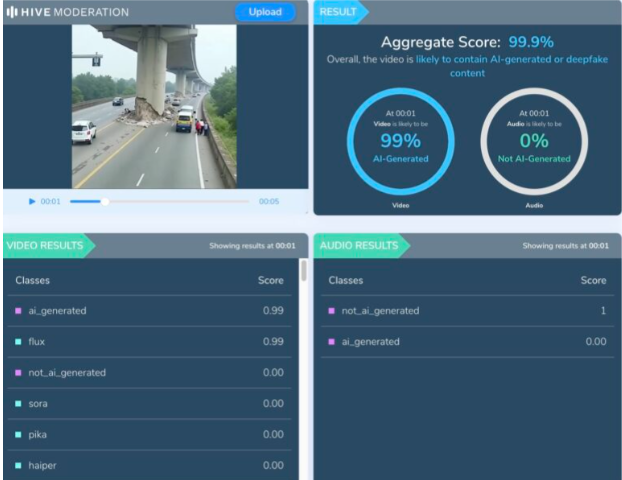#FactCheck: Viral video claims BSF personnel thrashing a person selling Bangladesh National Flag in West Bengal
Executive Summary:
A video circulating online claims to show a man being assaulted by BSF personnel in India for selling Bangladesh flags at a football stadium. The footage has stirred strong reactions and cross border concerns. However, our research confirms that the video is neither recent nor related to the incident that occurred in India. The content has been wrongly framed and shared with misleading claims, misrepresenting the actual incident.
Claim:
It is being claimed through a viral post on social media that a Border Security Force (BSF) soldier physically attacked a man in India for allegedly selling the national flag of Bangladesh in West Bengal. The viral video further implies that the incident reflects political hostility towards Bangladesh within Indian territory.

Fact Check:
After conducting thorough research, including visual verification, reverse image searching, and confirming elements in the video background, we determined that the video was filmed outside of Bangabandhu National Stadium in Dhaka, Bangladesh, during the crowd buildup prior to the AFC Asian Cup. A match featuring Bangladesh against Singapore.

Second layer research confirmed that the man seen being assaulted is a local flag-seller named Hannan. There are eyewitness accounts and local news sources indicating that Bangladeshi Army officials were present to manage the crowd on the day under review. During the crowd control effort a soldier assaulted the vendor with excessive force. The incident created outrage to which the Army responded by identifying the officer responsible and taking disciplinary measures. The victim was reported to have been offered reparations for the misconduct.

Conclusion:
Our research confirms that the viral video does not depict any incident in India. The claim that a BSF officer assaulted a man for selling Bangladesh flags is completely false and misleading. The real incident occurred in Bangladesh, and involved a local army official during a football event crowd-control situation. This case highlights the importance of verifying viral content before sharing, as misinformation can lead to unnecessary panic, tension, and international misunderstanding.
- Claim: Viral video claims BSF personnel thrashing a person selling Bangladesh National Flag in West Bengal
- Claimed On: Social Media
- Fact Check: False and Misleading
Related Blogs

Introduction
Cert-In (Indian Computer Emergency Response Team) has recently issued the “Guidelines on Information Security Practices” for Government Entities for Safe & Trusted Internet. The guideline has come at a critical time when the Draft Digital India Bill is about to be released, which is aimed at revamping the legal aspects of Indian cyberspace. These guidelines lay down the policy framework and the requirements for critical infrastructure for all government organisations and institutions to improve the overall cyber security of the nation.
What is Cert-In?
A Computer Emergency Response Team (CERT) is a group of information security experts responsible for the protection against, detection of and response to an organisation’s cybersecurity incidents. A CERT may focus on resolving data breaches and denial-of-service attacks and providing alerts and incident handling guidelines. CERTs also conduct ongoing public awareness campaigns and engage in research aimed at improving security systems. The Ministry of Electronics and Information Technology (MeitY) oversees CERT-In. It regularly releases alerts to help individuals and companies safeguard their data, information, and ICT (Information and Communications Technology) infrastructure.
Indian Computer Emergency Response Team (CERT-In) has been established and appointed as national agency in respect of cyber incidents and cyber security incidents in terms of the provisions of section 70B of Information Technology (IT) Act, 2000.
CERT-In requests information from service providers, intermediaries, data centres, and body corporates to coordinate reaction actions and emergency procedures regarding cyber security incidents. It is a focal point for incident reporting and offers round-the-clock security services. It manages cyber occurrences that are tracked and reported while continuously analysing cyber risks. It strengthens the security barriers for the Indian Internet domain.
Background
India is fast becoming one of the world’s largest connected nations – with over 80 Crore Indians (Digital Nagriks) presently connected and using the Internet and cyberspace – and with this number is expected to touch 120 Crores in the coming few years. The Digital Nagriks of the country are using the Internet for business, education, finance and various applications and services including Digital Government services. Internet provides growth and innovation and at the same time it has seen rise in cybercrimes, user harm and other challenges to online safety. The policies of the Government are aimed at ensuring an Open, Safe & Trusted and Accountable Internet for its users. Government is fully cognizant and aware of the growing cyber security threats and attacks.
It is the Government of India’s objective to ensure that Digital Nagriks experience a Safe & Trusted Internet. Along with ubiquitous applications of Information & Communication Technologies (ICT) in almost all facets of service delivery and operations, continuously evolving cyber threats have become a concern for the Government. Cyber-attacks can come in the form of malware, ransomware, phishing, data breach etc., that adversely affect an organisation’s information and systems. Cyber threats leading to cyber-attacks or incidents can compromise the confidentiality, integrity, and availability of an organisation’s information and systems and can have far reaching impact on essential services and national interests. To protect against cyber threats, it is important for government entities to implement strong cybersecurity measures and follow best practices. As ICT infrastructure of the Government entities is one of the preferred targets of the malicious actors, responsibility of implementing good cyber security practices for protecting computers, servers, applications, electronic systems, networks, and data from digital attacks, also remain with the ICT assets’ owner i.e. Government entity.
What are the new Guidelines about?
The Government of India (distribution of business) Rules, 1961’s First Schedule lists a number of Ministries, Departments, Secretariats, and Offices, along with their affiliated and subordinate offices, which are all subject to the rules. They also comprise all governmental organisations, businesses operating in the public sector, and other governmental entities under their administrative control.
“The government has launched a number of steps to guarantee an accessible, trustworthy, and accountable digital environment. With a focus on capabilities, systems, human resources, and awareness, we are extending and speeding our work in the area of cyber security, according to Rajeev Chandrasekhar, Minister of State for Electronics, Information Technology, Skill Development, and Entrepreneurship.
The Recommendations
- Various security domains are covered in the standards, including network security, identity and access management, application security, data security, third-party outsourcing, hardening procedures, security monitoring, incident management, and security audits.
- For instance, the rules advise using only a Standard User (non-administrator) account to use computers and laptops for regular work regarding desktop, laptop, and printer security in the workplace. Users may only be granted administrative access with the CISO’s consent.
- The usage of lengthy passwords containing at least eight characters that combine capital letters, tiny letters, numerals, and special characters; Never save any usernames or passwords in your web browser. Likewise, never save any payment-related data there.
- They include guidelines created by the National Informatics Centre for Chief Information Security Officers (CISOs) and staff members of Central government Ministries/Departments to improve cyber security and cyber hygiene in addition to adhering to industry best practises.
Conclusion
The government has been proactive in the contemporary times to eradicate the menace of cybercrimes and therreats from the Indian cyberspace and hence now we have seen a series of new bills and polices introduced by the Ministry of Electronics and Information Technology, and various other government organisations like Cert-In and TRAI. These policies have been aimed towards being relevant to time and current technologies. The threats from emerging technologies like web 3.0 cannot be ignored and hence with active netizen participation and synergy between government and corporates will lead to a better and improved cyber ecosystem in India.

Introduction
In an alarming event, one of India’s premier healthcare institutes, AIIMS Delhi, has fallen victim to a malicious cyberattack for the second time in the year. The Incident serves as a clear-cut reminder of the escalating threat landscape faced by the healthcare organisation in this digital age. In the attack, which unfolded with grave implications, the attackers not only explored the vulnerabilities present in the healthcare sector, but this also raised the concern about the security of patient data and the uninterrupted delivery of critical healthcare services. In this blog post, we will explore the incident, what happened, and what safety measures can be taken.
Backdrop
The cyber-security systems deployed in AIIMS, New Delhi, recently detected a malware attack. The nature and scope of the attack were both sophisticated and targeted. This second hack acts as a wake-up call for healthcare organisations nationwide. As the healthcare business increasingly depends on digital technology to improve patient care and operational efficiency, cybersecurity must be prioritised to protect sensitive data. To minimise cyber-attack dangers, healthcare organisations must invest in robust defences such as multi-factor authentication, network security, frequent system upgrades, and employee training.
The attempt was successfully prevented, and the deployed cyber-security systems neutralised the threat. The e-Hospital services remain to be fully secure and are functioning normally.
Impact on AIIMS
Healthcare services have been under hackers’ radar worldwide, and the healthcare sector has been impacted badly. The attack on AIIMS Delhi’s effects has been both immediate and far-reaching. The organisation, which is recognised for delivering excellent healthcare services and performing breakthrough medical research, faced significant interruptions in its everyday operations. Patient care and treatment processes were considerably impeded, resulting in delays, cancellations, and the inability to access essential medical documents. The stolen data raises serious concerns about patient privacy and confidentiality, raising doubts about the institution’s capacity to protect sensitive information. Furthermore, the financial ramifications of the assault, such as the cost of recovery, deploying more robust cybersecurity measures, and potential legal penalties and forensic analyses, contribute to the scale of the effect. The event has also generated public concerns about the institution’s ability to preserve personal information, undermining confidence and degrading AIIMS Delhi’s image.
Impact on Patients: The attacks not only impact the institutes but also have serious implications for the patients and here are some key highlights:
Healthcare Service Disruption: The hack has affected the seamless delivery of healthcare services at AIIMS Delhi. Appointments, surgeries, and other medical treatments may be delayed, cancelled, or rescheduled. This disturbance can result in longer wait times, longer treatment periods, and potential problems from delayed or interrupted therapy.

Patient Privacy and Confidentiality are jeopardised because of the breach of sensitive patient data. Medical data, test findings, and treatment plans may have been compromised. This breach may diminish patient faith in the institution’s capacity to safeguard their personal information, discouraging them from seeking care or submitting sensitive information in the future.
As a result of the cyberattack, patients may endure mental anguish and worry. Fear of possible exploitation of personal health information, confusion about the scope of the breach, and concerns about the security of their healthcare data can all have a negative impact on their mental health. This stress might aggravate pre-existing medical issues and impede total recovery.
Trust at stake: A data breach may harm patients’ faith and confidence in AIIMS Delhi and the healthcare system. Patients rely on healthcare facilities to keep their information secure and confidential while providing safe, high-quality care. A hack can doubt the institution’s ability to safeguard patient data, affecting patients’ overall faith in the organisation and potentially leading to patients seeking care elsewhere.
Cybersecurity Measures
To avoid future hacks and protect patient data, AIIMS Delhi must prioritize enhancing its cybersecurity procedures. The institution can strengthen its resistance to changing threats by establishing strong security practices. The following steps can be considered.
Using Multi-factor Authentication: By forcing users to submit several forms of identity to access systems and data, multi-factor authentication offers an extra layer of protection. AIIMS Delhi may considerably lower the danger of unauthorised access by applying this precaution, even in the case of leaked passwords or credentials. Biometrics and one-time passwords, for example, should be integrated into the institution’s authentication systems.
Improving Network Security and Firewalls: AIIMS Delhi should improve network security by implementing strong firewalls, intrusion detection and prevention systems, and network segmentation. These techniques serve to construct barriers between internal systems and external threats, reducing attackers’ lateral movement within the network. Regular network traffic monitoring and analysis can assist in recognising and mitigating any security breaches.
Risk Assessment: Regular penetration testing and vulnerability assessments are required to uncover possible flaws and vulnerabilities in AIIMS Delhi’s systems and infrastructure. Security professionals can detect vulnerabilities and offer remedial solutions by carrying out controlled simulated assaults. This proactive strategy assists in identifying and addressing any security flaws before attackers exploit them.
Educating and training Healthcare Professionals: Education and training have a crucial role in enhancing cybersecurity practices in healthcare facilities. Healthcare workers, including physicians, nurses, administrators, and support staff, must be well-informed about the importance of cybersecurity and trained in risk-mitigation best practices. This will empower healthcare professionals to actively contribute to protecting the patient’s data and maintaining the trust and confidence of patients.
Learnings from Incidents
AIIMS Delhi should embrace cyber-attacks as learning opportunities to strengthen its security posture. Following each event, a detailed post-incident study should be performed to identify areas for improvement, update security policies and procedures, and improve employee training programs. This iterative strategy contributes to the institution’s overall resilience and preparation for future cyber-attacks. AIIMS Delhi can effectively respond to cyber incidents, minimise the impact on operations, and protect patient data by establishing an effective incident response and recovery plan, implementing data backup and recovery mechanisms, conducting forensic analysis, and promoting open communication. Proactive measures, constant review, and regular revisions to incident response plans are critical for staying ahead of developing cyber threats and ensuring the institution’s resilience in the face of potential future assaults.

Conclusion
To summarise, developing robust healthcare systems in the digital era is a key challenge that healthcare organisations must prioritise. Healthcare organisations can secure patient data, assure the continuation of key services, and maintain patients’ trust and confidence by adopting comprehensive cybersecurity measures, building incident response plans, training healthcare personnel, and cultivating a security culture. Adopting a proactive and holistic strategy for cybersecurity is critical to developing a healthcare system capable of withstanding and successfully responding to digital-age problems.

Executive Summary:
A video went viral on social media claiming to show a bridge collapsing in Bihar. The video prompted panic and discussions across various social media platforms. However, an exhaustive inquiry determined this was not real video but AI-generated content engineered to look like a real bridge collapse. This is a clear case of misinformation being harvested to create panic and ambiguity.

Claim:
The viral video shows a real bridge collapse in Bihar, indicating possible infrastructure failure or a recent incident in the state.
Fact Check:
Upon examination of the viral video, various visual anomalies were highlighted, such as unnatural movements, disappearing people, and unusual debris behavior which suggested the footage was generated artificially. We used Hive AI Detector for AI detection, and it confirmed this, labelling the content as 99.9% AI. It is also noted that there is the absence of realism with the environment and some abrupt animation like effects that would not typically occur in actual footage.

No valid news outlet or government agency reported a recent bridge collapse in Bihar. All these factors clearly verify that the video is made up and not real, designed to mislead viewers into thinking it was a real-life disaster, utilizing artificial intelligence.
Conclusion:
The viral video is a fake and confirmed to be AI-generated. It falsely claims to show a bridge collapsing in Bihar. This kind of video fosters misinformation and illustrates a growing concern about using AI-generated videos to mislead viewers.
Claim: A recent viral video captures a real-time bridge failure incident in Bihar.
Claimed On: Social Media
Fact Check: False and Misleading


